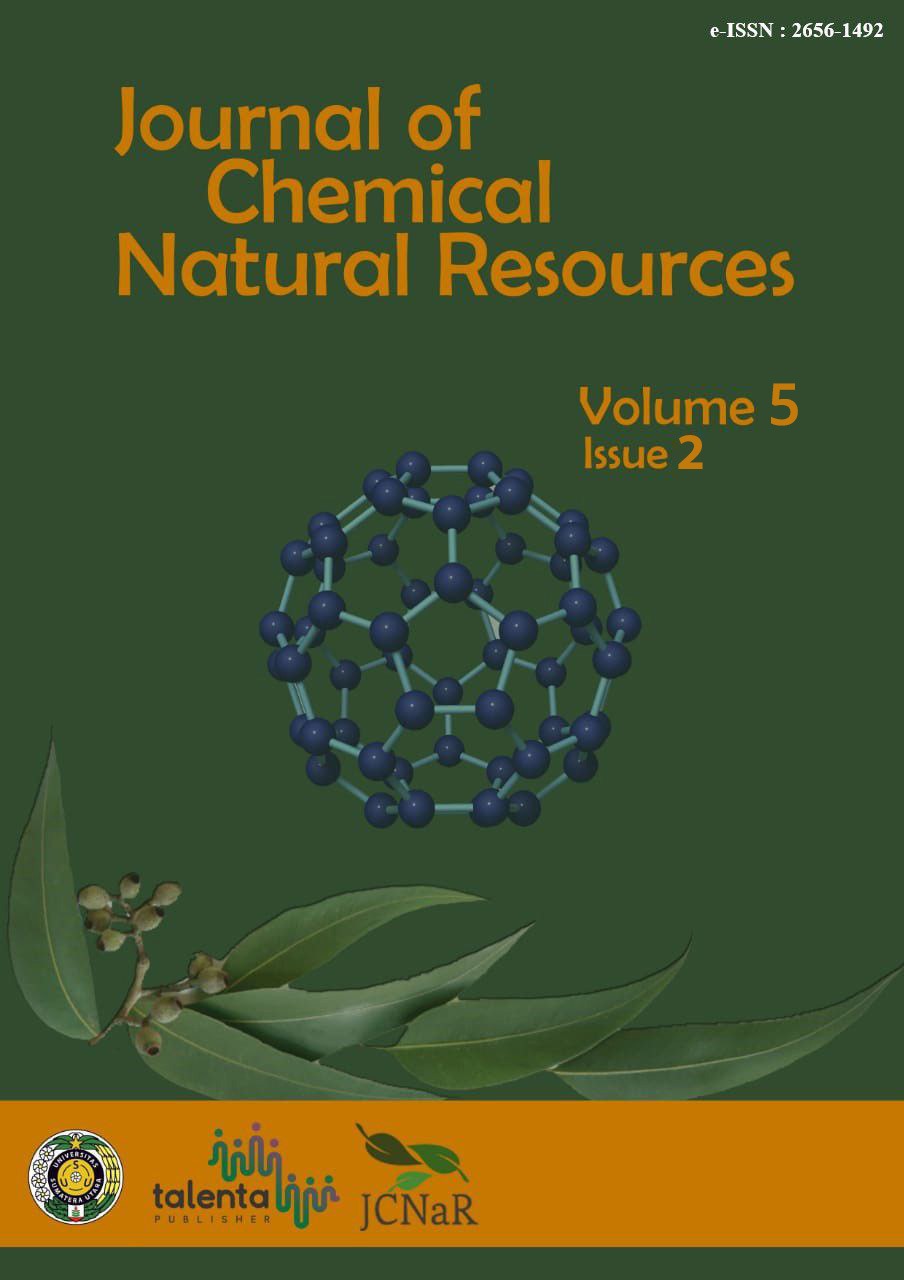Synthesis of Methyl Cellulose from Rice Husk Cellulose (Oryza sativa L.) with Methylene Chloride Through Etherification Reaction
DOI:
https://doi.org/10.32734/jcnar.v5i2.13836Keywords:
Cellulose, Etherification Methyl Cellulose, Methylene ChlorideAbstract
Methyl cellulose is synthesized by an etherification reaction between α-cellulose created by isolating rice husks (Oryza sativa L.) with methylene chloride. Methylcellulose synthesis is performed by combining 1 g α-cellulose with acetone solvents at variations of methylene chloride 6 g, 8 g, 10 g, 12 g, and 14 g for 6 hours, resulting in 0.47 g, 0.60 g, 0.58 g; 0.51 g; and 0.69 g of methylcellulose. The results of methyl cellulose synthesis were tested with Degrees of  Substitution, FT-IR spectroscopic analysis, and surface morphology using SEM. In the variation of methylene chloride, methylcellulose has the highest degree of replacement (14 g of 01,17). The formation of methyl cellulose is supported by FT-IR spectroscopy, namely with the appearance of vibration peaks in the wave number area of 3295.0 cm-1, which shows the -OH group, the C-H stretching group at wave number 2892.4 cm-1, the absorption peak that indicates the presence of C-O-C is found in wave numbers 1152.6 cm-1 and 1021.3 cm-1 where it is an asymmetrical and symmetrical stretching vibration. Morphological analysis using SEM showed that cellulose fibers' surface is smoother than methylcellulose. The average size of cellulose and methyl cellulose fibers is 4.791 μm and 3.828 μm, respectively. Morphological analysis using SEM showed that the surface fibers in cellulose were smoother than methylcellulose. The average size of cellulose and methyl cellulose fibers was 4.791 μm and 3.828 μm.
Downloads
References
Nurlia, “Mix Sekam Padi, Bonggol Jagung dan Tempurung Kelapa Sebagai Pestisida Alami.†CV. Jejak. Jawa Barat, 2020.
K. Rahayu, Teknologi Pengolahan Beras, II. Yogyakarta: Gadjah Mada University Press, 2008.
Jalaluddin and S. Rizal, “Pembuatan Pulp dari Jerami Padi menggunakan Natrium Hidroksida,†Sist. Tek. Ind., vol. 6, pp. 53–58, 2005.
Y. Setiyawan, Peranan Polimer Selulosa Sebagi Bahan Baku dalam Pengembangan Produk Manufaktur Menuju Era Globalisasi. Bandung: Universitas Islam Indonesia, 2010.
C. Saurabh et al., “Isolation and Characterization of Cellulose Nanofibers from Gigantochloa Scortechnii as a Reinforcement Material,†J. Nanomater., vol. 2016, 2016.
A. Yakubu, M. Tanko, S. Umar, and S. Mohammed, “Chemical Modification of Microcrystaline Cellulose: Improvement of Barrier Surface Propertiesto Enhance Surface Interaction with Some Synthetic Polymers for Biodegradable Packaging Material Processing and Applications in Textile, Food and Pharmaceutical I,†Adv. Appl. Sci. Res., vol. 2, no. 6, pp. 532–540, 2011.
K. Hong, “Preparation and Characterization of Carboxymethyl Cellulose from Sugarcane Bagasse,†University Tunku Abdul Rahman Malaysia, 2013.
S. Spinella and A. Maiorana, “Concurrent Cellulose Hydrolysis and Esterification to Prepare a Surface-Modified Cellulose Nanocrystal Decorated with Carboxylic Acid Moieties,†ACS Sustain. Chem. Eng, vol. 2016, no. 4, p. 1538−1550, 2015.
N. Cetin, P. Tingaut, N. Ozmen, and N. Henry, Acetylation of Cellulose Nanowhiskers with Vinyl Acetate under Moderate Conditions. Chine: Changcun Intitute, 2009.
L. Rahmidar, S. Wahidiniawati, and T. Sudiarti, “Pembuatan dan Karakteristik Metil Selulosa dari Bonggol dan Kulit Nanas (Ananas comosus).,†ALOTROP J. Sci. Educ., pp. 88–96, 2018.
Wahyuningtyas, Optimasi Sintesis Methyl Cellulose (MC) dari Biji Salak (Salacca edulis Reinw) Pondoh Super. Lampung: Institut Teknologi Sumatera, 2021.
R. Andalia, R. Rahmi, J. Julinawati, and H. Helwati, “Isolation and Characterization of Cellulose From Rice Husk Waste and Sawdust With Chemical Method,†J. Nat., vol. 20, no. 1, pp. 6–9, 2020.
R. Viera, F. . Rodrigues, R. Assunção, De, C. Meireles, J. Vieira, and de O. GS, “Synthesis and Characterization of Methylcellulose from Sugarcane Bagasse Cellulose,†Carbohydr. Polym., vol. 67, no. 2, pp. 182–189, 2007.
R. Oliveira et al., “Synthesis and Characterization of Methylcellulose Produced from Bacterial Cellulose Under Heterogeneous Condition,†J. Braz. Chem. Soc., vol. 26, no. 9, pp. 1861–1870, 2015.
J. Vieira et al., “Synthesis and Characterization of Methylcellulose from Cellulose Extracted from Mango Seeds for Use as a Mortar additive,†Polimeros, vol. 22, no. 1, pp. 80–87, 2012.
G. Filho et al., “Characterization of Methylcellulose Produced From Sugar Cane Bagasse Cellulose: Crystallinity and Thermal Properties,†Polym. Degrad. Stab., vol. 92, no. 2, pp. 205–210, 2007.
T. Aziz et al., “A Review on the Modification of Cellulose and Its Applications,†Polymers (Basel)., vol. 14, no. 15, 2022, doi: 10.3390/polym14153206.

Downloads
Published
Issue
Section
License
Copyright (c) 2023 Journal of Chemical Natural Resources

This work is licensed under a Creative Commons Attribution-ShareAlike 4.0 International License.














